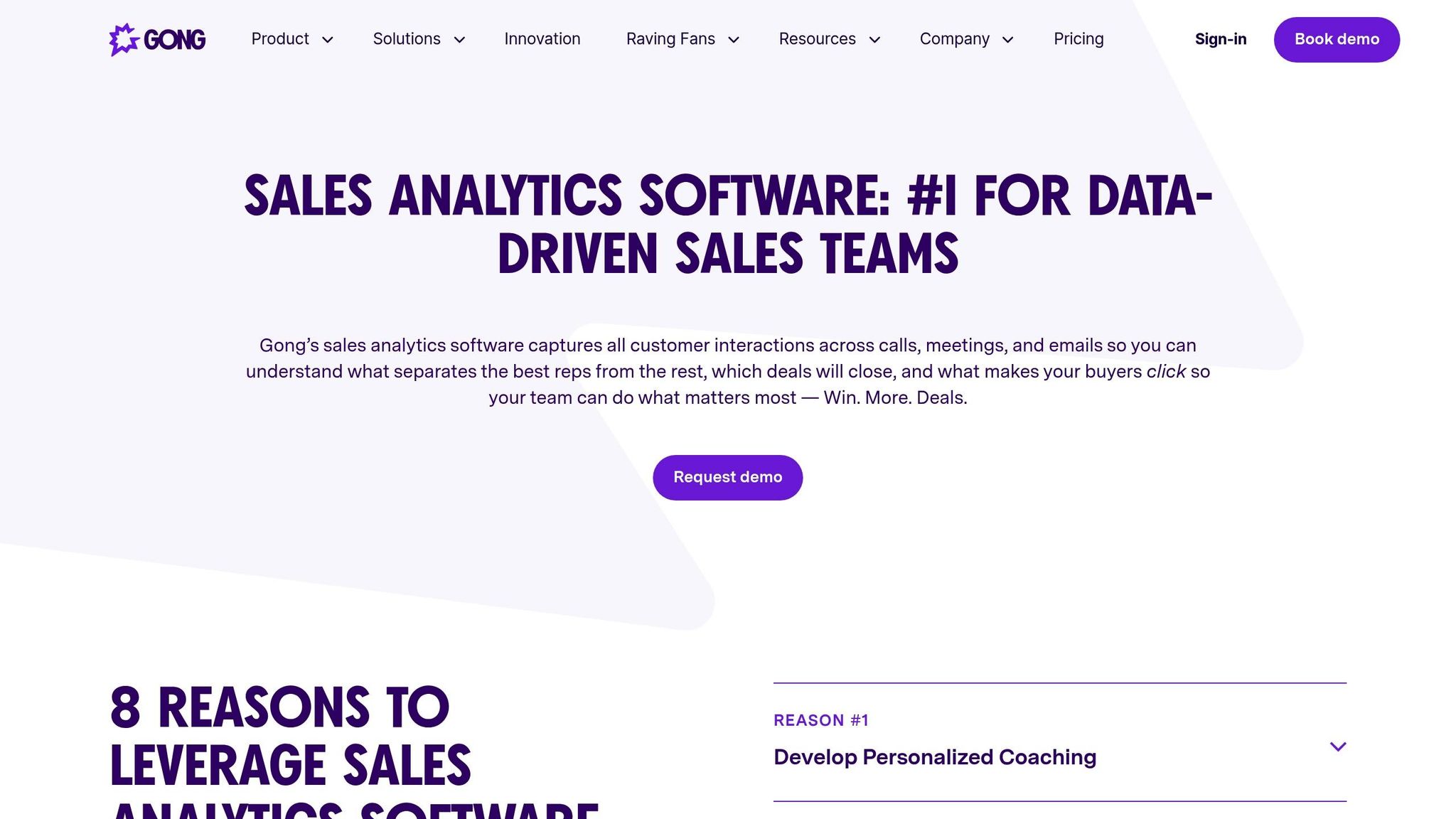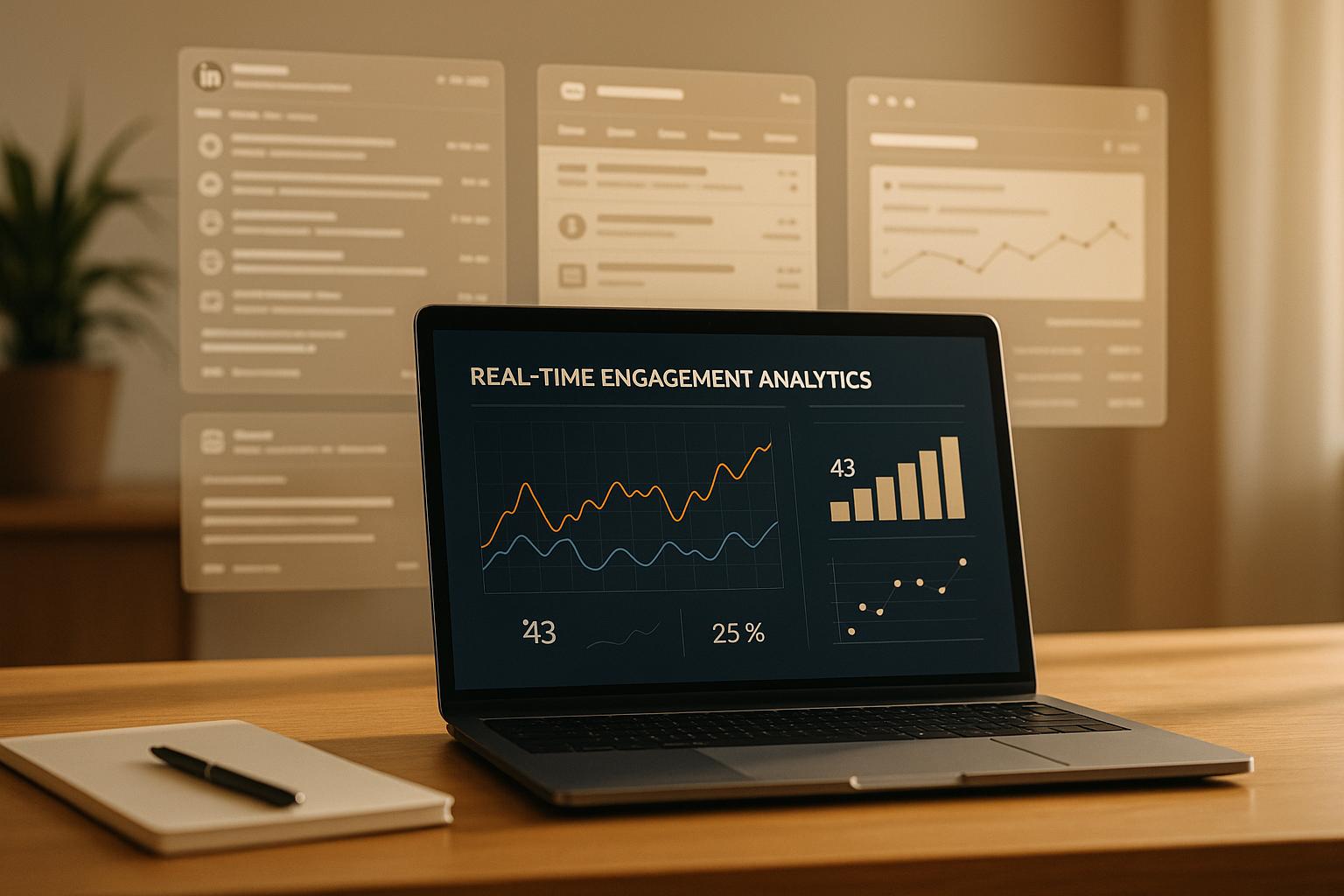
.avif)
Julien Gadea
Julien Gadea specializes in AI prospecting solutions for business growth. Empowering businesses to connect with their audience with SalesMind AI tools that automate your sales funnel, starting from lead generation.
AI is transforming B2B sales by replacing outdated metrics with predictive, real-time insights. Here's what you need to know:
- Boosted Results: Companies using AI report up to 30% higher lead conversion rates, 35% more accurate forecasts, and 10–25% shorter sales cycles.
- Key Metrics: AI improves win rates, deal sizes, sales cycle lengths, and revenue per sales rep by analyzing buyer behavior and sales patterns.
- Pipeline Insights: AI scores deals, detects risks, and predicts outcomes, helping sales teams focus on high-potential opportunities.
- Lead Scoring: AI identifies and prioritizes the best leads, increasing lead-to-opportunity conversion rates by 15–25%.
- Sales Engagement: Tools analyze conversations to improve talk-to-listen ratios, next-step confirmations, and discovery questions for better performance.
Takeaway: AI metrics enable sales teams to work smarter, focusing on predictive insights and actionable strategies to close more deals faster.
B2B SaaS Sales: Using AI to close more deals and boost productivity | Martin Garvey, Gong

Core Revenue Metrics Improved by AI
Revenue metrics are the lifeblood of B2B sales, but traditional methods often rely on outdated data, showing what happened rather than what’s ahead. AI changes the game by introducing predictive capabilities, real-time analysis, and pattern recognition, enabling sales teams to tackle challenges before they arise and fine-tune their strategies for better results.
This shift from static reports to AI-driven insights is revolutionizing how sales teams evaluate and improve revenue generation. Instead of waiting for quarterly reports to spot trends, AI continuously evaluates deal patterns, buyer behaviors, and sales activities, delivering actionable insights that drive immediate improvements.
Win Rate and Deal Size
AI has redefined how win rates and deal sizes are analyzed. By examining historical sales data, buyer behaviors, and deal specifics, AI can predict which opportunities are most likely to succeed. It doesn’t stop there - AI learns from real-world sales outcomes to refine these predictions over time. For instance, modern AI tools analyze sales calls and emails to pinpoint what leads to closed deals, helping teams focus on high-value opportunities [2][4]. AI also tracks win rates by deal stage, sales rep, and industry, uncovering patterns that would otherwise go unnoticed.
When it comes to deal size, AI takes a similar approach. By analyzing customer interactions, purchase histories, and engagement signals, AI identifies upsell and cross-sell opportunities. It recommends which accounts are ready for larger deals or additional products, boosting the average deal size by 10–20% for companies leveraging AI-powered analytics [2][6][8].
Rather than just presenting current win rates, AI highlights which deals in the pipeline are most likely to close - and, crucially, why. This enables teams to act proactively rather than reactively, improving overall revenue through targeted interventions.
Sales Cycle Length
AI shines in identifying bottlenecks in the sales cycle. By analyzing deal progression, stage durations, and conversion rates, it flags opportunities that are moving slower than expected, giving sales managers an early warning [4][5]. AI also evaluates factors like response times, engagement levels, and stakeholder involvement to predict which deals might stall, allowing for timely adjustments [3].
Additionally, AI tools equipped with conversation intelligence analyze sales meetings to spot where discussions break down or where extra coaching is needed [2]. These insights help reduce sales cycle lengths by 10–25% through automation and real-time feedback [6]. AI even suggests next steps based on deal velocity patterns, empowering sales reps to move opportunities forward more efficiently [8].
By streamlining the sales process and focusing on actionable insights, AI helps sales teams spend their time more effectively, improving both individual and team performance.
Revenue Per Sales Representative
AI takes a closer look at revenue per sales representative by breaking the metric into smaller, actionable components - like revenue by deal stage, customer segment, or type of sales activity [4][8]. It identifies the habits and behaviors of top-performing reps, turning those insights into strategies that can be applied across the team [8]. Instead of just tracking total revenue, AI highlights the specific techniques and engagement strategies that drive the most success.
It also provides predictive insights into individual performance. For example, AI can forecast which reps are at risk of missing their quotas based on activity levels and pipeline health, enabling managers to step in with targeted coaching before problems escalate [4]. By automating routine tasks, AI frees up 15–25% more time for reps to focus on revenue-generating activities and reduces administrative workloads by 20–30% [6]. AI further tracks performance across customer segments and deal types, helping managers identify where reps excel and where they might need additional development. These insights transform individual metrics into powerful tools for driving overall revenue growth [8].
| Metric | AI-Driven Improvement | Benchmark Result |
|---|---|---|
| Sales Cycle Length | Reduction | 10–25% |
| Deal Size | Increase | 10–20% |
| Win Rate/Conversion Rate | Increase | 5–15% |
| Administrative Tasks | Reduction | 20–30% |
| High-Value Selling Time | Increase | 15–25% |
Together, these metrics provide a complete picture of sales performance, moving beyond traditional reporting to deliver predictive insights and actionable recommendations. AI doesn’t just measure past performance - it anticipates future trends and equips sales teams with the tools to act on them. This shift from reactive reporting to proactive strategy is what makes AI-driven revenue metrics such a game-changer for B2B sales teams.
Pipeline Health and Predictive Metrics
Pipeline health isn’t just about counting the deals in your funnel - it’s about identifying which opportunities are likely to succeed, spotting bottlenecks, and predicting what your pipeline will deliver. AI takes this process from guesswork to precision by analyzing engagement patterns, historical data, and behavioral signals.
With AI-powered pipeline analysis, sales teams can address issues before they escalate. For example, AI can detect declining engagement in real time and assign a probability score to each opportunity, offering a clear snapshot of pipeline health. This proactive approach helps teams better understand deal risks, sales velocity, and future revenue potential.
Deal Scoring and Risk Detection
AI uses a variety of data points - like engagement levels, communication frequency, deal progression speed, and historical win rates - to assign probability scores to each deal. These scores aren’t static; they’re updated continuously as new information comes in, making predictions more accurate over time.
Risk detection is another critical feature. For example, if a prospect who usually responds quickly starts delaying replies or their tone becomes less positive, AI can flag these changes and alert the sales team.
In 2024, Microsoft adopted AI-driven sales analytics to identify at-risk deals and provide personalized recommendations. This initiative led to a 15% drop in deal losses by catching early warning signs and suggesting targeted interventions [6].
One standout aspect of AI-driven deal scoring is its ability to learn from outcomes. When a deal is won or lost, the system analyzes what contributed to the result and uses that information to refine future predictions. This helps sales teams prioritize the deals most likely to convert.
Pipeline Velocity
Pipeline velocity tracks how quickly deals move through the sales stages. AI calculates average time spent in each stage, identifies stalled opportunities, and compares current deals against historical benchmarks. This analysis can uncover patterns, like specific deal types facing recurring delays, allowing managers to allocate resources strategically and set more realistic goals.
AI also offers actionable advice to speed up deal progression. For instance, if an opportunity is stuck in a stage longer than usual, the system might recommend scheduling a follow-up call, sharing additional resources, or involving another decision-maker to keep things moving. These insights don’t just improve deal flow - they also lead to more accurate revenue forecasts.
Forecasting Pipeline Outcomes
AI-powered forecasting leverages historical trends, real-time data, and market signals to predict revenue outcomes with a level of accuracy that traditional methods can’t match.
In 2023, a B2B company used AI forecasting to refine its sales projections, which resulted in a 20% reduction in inventory costs and a 15% boost in resource efficiency [7]. Modern forecasting tools also offer scenario planning, enabling sales leaders to adapt strategies as conditions change.
| Metric | AI Improvement | Impact |
|---|---|---|
| Deal Loss Reduction | Early risk detection | 15% fewer lost deals |
| Forecast Accuracy | Predictive modeling | 20–35% improvement |
| Inventory Costs | Better demand prediction | 20% reduction |
| Resource Utilization | Optimized allocation | 15% increase |
Lead Generation and Qualification Metrics
AI is revolutionizing the way businesses handle lead generation and qualification. What used to be manual, time-consuming work is now streamlined through automated systems that identify and prioritize the most promising prospects. By focusing on the right metrics, sales teams can measure how effectively AI tools are filling their pipelines with high-quality opportunities.
The real power of AI in lead generation lies in its ability to sift through massive amounts of data and uncover patterns that might otherwise go unnoticed. For example, AI can pick up on subtle signals - like repeated visits to pricing pages or downloading case studies - that suggest genuine interest. With measurable metrics like lead volume, conversion rates, and scoring, these insights are turned into actionable results.
Lead Volume and Qualification Rates
AI doesn't just boost the number of leads - it also improves their quality. Traditional prospecting often involves hours of manual research and outreach, limiting how many potential customers a sales rep can contact in a day. AI automates this process by scanning digital channels, databases, and social platforms to find leads that match your ideal customer profile.
According to research by McKinsey, B2B sales teams that fully leverage AI see over 50% more leads and appointments, while cutting costs by 40–60% [10]. Tools like SalesMind AI take this a step further, automating LinkedIn outreach and follow-ups. By using advanced lead scoring, these platforms filter out low-potential leads, ensuring that only the most valuable prospects make it into your pipeline.
The qualification rate - measuring the percentage of leads that are sales-ready - also sees a boost with AI. By analyzing firmographic data, behavioral signals, and engagement patterns, AI ensures that only high-quality leads reach your sales team. Companies using AI for lead qualification report efficiency gains of 10–20% [6].
Lead-to-Opportunity Conversion Rates
Turning qualified leads into actual sales opportunities requires pinpointing which prospects are ready to engage. AI excels in this area by tracking engagement patterns, buying signals, and historical data to predict which leads are most likely to convert.
AI also personalizes outreach at scale, making engagement more effective. Instead of sending generic messages, AI tailors communications based on each lead's profile, company details, and digital activity. Companies using AI-powered lead scoring report year-over-year conversion rate increases of 15–20% or more [11]. AI further enhances timing by monitoring digital signals - like website visits or content downloads - and notifying sales reps when prospects are actively researching solutions.
AI-Powered Lead Scoring
Lead scoring is where AI truly shines, helping sales teams prioritize their efforts. Traditional scoring models rely on basic demographic and firmographic data, but AI goes deeper. It incorporates behavioral signals, engagement trends, and predictive analytics to create dynamic scores that continuously adapt.
"The lead scoring system is particularly impressive, providing clear insights into lead quality", says Svit Babarovic from MountainDrop [1].
AI-powered scoring analyzes data from multiple sources - CRM interactions, website behavior, email engagement, and social media activity - to assign scores that reflect both how closely a prospect matches your ideal customer profile and their likelihood to make a purchase. This allows sales teams to focus on the highest-value opportunities.
What sets AI apart is its ability to spot patterns that humans might miss. For instance, frequent visits to pricing pages combined with multiple content downloads can signal strong buying intent. AI identifies these nuances, enabling more precise lead prioritization over time.
"I like that it shows you a score on what the lead suitability with your filters is", explains Jure, CEO of Jure Design [1].
AI scoring doesn't just prioritize leads - it also informs how sales reps approach them. High-scoring leads might warrant an immediate phone call, while medium-scoring prospects could receive a personalized email sequence. This tailored approach ensures sales efforts align with each prospect's level of interest and intent.
| Metric | AI Improvement | Business Impact |
|---|---|---|
| Lead Generation Volume | +50% more leads | More opportunities in the pipeline |
| Lead Qualification Efficiency | +10–20% improvement | Less time wasted on unqualified leads |
| Lead Conversion Rate | +15–25% increase | More opportunities created |
| Engagement Rate | +35% improvement | Stronger prospect interactions |
Modern AI scoring systems also offer transparency. Sales teams can see exactly which factors contributed to a lead's score, helping them understand why certain prospects rank higher and enabling more effective outreach strategies.
sbb-itb-817c6a5
Sales Engagement and Conversation Metrics
Using AI to improve sales processes isn't just about streamlining tasks - it's also about gaining a deeper understanding of how sales teams engage with prospects. While traditional activity metrics like call volume or email frequency show how busy a team is, AI-powered conversation analytics dives into the quality of those interactions. This analysis uncovers what sets top-performing reps apart, giving managers actionable insights to improve team performance.
AI tools do more than just transcribe conversations. They evaluate how well sales reps communicate, engage with prospects, and move deals forward. By shifting the focus from quantity to quality, these tools help managers provide more targeted coaching and ensure that reps are better aligned with their buyers' needs.
One standout advantage of AI is its ability to spot patterns that manual reviews might miss. By analyzing thousands of sales calls, AI can identify behaviors that lead to closed deals, shorter sales cycles, and stronger customer relationships. A key part of this analysis involves tracking specific conversational metrics, starting with talk-to-listen ratios.
Talk-to-Listen Ratios
One of the most insightful metrics AI tracks is how much time reps spend talking versus listening. Research suggests that the ideal talk-to-listen ratio is about 43–57% rep talk time, which reflects strong two-way communication and active listening [4]. If reps dominate the conversation - talking more than 70% of the time - they risk losing the prospect's engagement. For example, Gong analyzed over 100,000 sales calls in Q2 2023 and discovered that deals where reps maintained a balanced 50/50 ratio had a 25% higher close rate compared to calls where reps talked too much [6]. These insights give managers concrete data to identify coaching opportunities and help reps improve their conversational approach.
But balancing the dialogue is just one piece of the puzzle. Reps also need to confirm actionable next steps to keep deals moving forward.
Next Steps Confirmation Rates
Top-performing sales reps consistently secure clear commitments at the end of their conversations. AI tools can analyze call transcripts to spot whether reps confirm next steps - like scheduling a follow-up or sending a proposal. Research shows that high performers confirm next steps in over 90% of their calls, a habit directly tied to stronger pipeline progression and higher close rates [4].
For instance, Chorus.ai partnered with a B2B SaaS company in early 2024, and within six months of focusing on next steps confirmation and discovery question metrics, the company saw a 15% boost in conversion rates and a 20% reduction in their average sales cycle length [11]. AI not only tracks whether next steps are confirmed but also evaluates the quality of those commitments, helping reps refine their strategies and close more deals.
Discovery Question Metrics
Great sales conversations often start with thoughtful discovery questions that uncover a prospect's needs, challenges, and decision-making criteria. AI-powered analytics can track how many of these questions are asked during a call, ensuring reps gather the insights they need to tailor their solutions. Research indicates that top-performing sales reps ask between 11 and 14 discovery questions per call [4]. Moreover, Gong's analysis found that reps who asked at least three discovery questions per call were 30% more likely to move deals to the next stage [6]. AI also monitors the timing and context of these questions, offering valuable feedback to help teams fine-tune their approach.
| Conversation Metric | Optimal Range | Impact on Performance |
|---|---|---|
| Talk-to-Listen Ratio | 43–57% rep talk time | 25% higher close rate when balanced |
| Next Steps Confirmation | 90%+ of calls | 15% increase in conversion rates |
| Discovery Questions | 11–14 per call | 30% more likely to advance deals to next stage |
Building on these insights, tools like SalesMind AI take things further by automating the analysis of LinkedIn outreach and sales conversations. Its unified inbox tracks engagement quality, ensuring reps don’t just reach prospects but also engage in meaningful, metric-driven conversations that drive results. On top of that, its advanced lead scoring helps identify which prospects are most likely to convert, making these metrics even more impactful for closing deals.
Best Practices for Implementing AI Metrics in B2B Sales
When it comes to using AI insights effectively, the way you select, define, and manage your metrics can make or break your analytics efforts. It’s not just about flipping on a dashboard; it’s about being strategic, maintaining clarity, and ensuring your data is reliable. Let’s dive into how to make your AI metrics work for you.
Defining Key Metrics for Success
One common pitfall for sales teams is trying to track every metric under the sun. Instead, focus on 5–7 key metrics that directly influence revenue [4]. These should align with your main sales goals, whether that’s closing deals faster, increasing win rates, or boosting deal sizes.
Start with outcome-focused metrics like win rate, average deal size, sales cycle length, and revenue per rep. Then, balance them with leading indicators like pipeline velocity and lead-to-opportunity conversion rates. These early indicators can help you spot trends before they impact your bottom line. For instance, if your goal is to shorten the time it takes to close deals, prioritize metrics like pipeline velocity and next-step confirmation rates rather than getting bogged down by irrelevant data.
A great example comes from HubSpot, which found that companies using AI chatbots saw a 25% jump in conversion rates [6]. This wasn’t because they tracked every possible KPI - it was because they focused on metrics tied to their specific goals.
As your team gets more comfortable with AI, you can gradually add more complexity. But starting simple is key. Teams that try to track too many metrics from the get-go often end up overwhelmed, unable to distinguish actionable insights from noise.
Once you’ve chosen your key metrics, it’s crucial to ensure they’re consistently defined across your organization.
Maintaining Consistent Metric Definitions
Inconsistent definitions can create chaos. For example, if one team includes renewals in their "deal size" calculation while another doesn’t, you’ll end up with conflicting data and misaligned strategies [4]. This not only confuses your teams but also undermines trust in your analytics.
To avoid this, create a centralized, easily accessible document that clearly defines each metric. Include details like how it’s calculated, the data sources it uses, and its purpose. Update this documentation whenever your sales processes change. For example, clarify whether "win rate" is based on deals closed within a quarter or total opportunities created, so everyone is on the same page.
Microsoft offers a great case study here. By using AI-powered analytics to flag at-risk deals and provide tailored recommendations, they reduced deal losses by 15% [6]. This success was built on consistent metric definitions across their global sales teams, enabling their AI tools to deliver accurate, actionable insights.
Regular cross-department reviews can also help catch any definition drift. When sales, marketing, and customer success teams share the same definitions, your AI tools can provide a clearer picture of the entire customer journey - from initial lead to closed deal.
Of course, even the best-defined metrics won’t work without clean, reliable data.
Maintaining Data Quality for AI Accuracy
AI is only as good as the data it processes. If your data is messy, your forecasts and insights will be unreliable. That’s why top-performing sales teams prioritize data quality through regular audits and automated validation [4].
Start by enforcing CRM hygiene. Sales reps should be required to enter complete and accurate data. For example, missing lead source information can throw off AI-powered lead scoring, leading your team to chase the wrong prospects [5]. Automating validation processes and training your team on CRM best practices can prevent these issues.
Kixie’s experience highlights the importance of clean data. Teams using their AI-powered tools tripled their outbound calls, boosted live-answer rates by 40%, and achieved 96% forecast accuracy [5]. These results were possible because they prioritized high-quality data, ensuring their AI models had the foundation needed to deliver meaningful insights.
It’s also worth educating your team on how their data entry habits affect AI accuracy. For example, using abbreviations or skipping fields might seem minor, but it can cause significant downstream errors. When reps understand the link between good data and actionable insights, they’re more likely to adopt better habits.
To make things easier, tools like SalesMind AI can automate data collection, reducing manual errors. Features like automated lead qualification and unified inbox management ensure consistent data capture while lightening the load on your sales team.
| Best Practice Area | Key Actions | Expected Impact |
|---|---|---|
| Metric Selection | Focus on 5–7 key KPIs tied to revenue | Avoid distractions, keep teams focused |
| Definition Consistency | Centralize documentation, conduct regular reviews | Enable accurate AI insights and comparisons |
| Data Quality | Automate validation, train reps on CRM hygiene | Boost forecast accuracy up to 96% |
Conclusion: Improving Sales Efficiency with AI Metrics
The move from traditional sales reporting to AI-powered metrics marks a major shift in how B2B sales teams operate. It's not just about upgrading technology - it's about changing the entire approach. Instead of reacting to past data, sales leaders can now anticipate risks, spot promising opportunities, and fine-tune processes in real time.
Companies leveraging AI in sales have reported a 15% increase in revenue and up to a 30% boost in productivity [9]. These gains provide a clear edge in competitive markets. As highlighted earlier, these metrics translate directly into measurable benefits across organizations.
AI metrics go beyond simply analyzing past performance; they turn raw data into actionable strategies. While traditional metrics tell you what happened, AI metrics reveal what’s likely to happen and suggest the best course of action. This enables sales teams to allocate resources wisely, focus on the right deals, and address issues before they escalate. For instance, one B2B company that adopted AI-driven sales forecasting reduced inventory costs by 20% and improved resource utilization by 15% through more accurate projections [7].
The benefits extend far beyond better forecasting. AI also automates time-consuming tasks like lead qualification and data entry. This isn't about replacing human expertise - it’s about enhancing it. By freeing up sales reps from repetitive work, AI gives them more time to build relationships and close deals.
Take tools like SalesMind AI as an example. These platforms automate LinkedIn outreach, lead qualification, and follow-ups, while offering advanced lead scoring and centralized inbox management. By handling these repetitive tasks and delivering actionable insights, tools like these empower sales teams to make quicker, smarter decisions that directly impact revenue.
To get started, focus on tracking the metrics that align most closely with your revenue goals. Stick to consistent metric definitions and prioritize high-quality data. As your team grows more comfortable with AI-driven insights, you can gradually expand your metrics framework to include deeper aspects of sales performance.
AI metrics aren’t just about doing the same things better - they’re about rethinking how you approach sales altogether. The companies that embrace this shift today will be the ones leading the way tomorrow.
FAQs
How can AI enhance the accuracy of sales forecasts in B2B sales?
AI has revolutionized sales forecasting in B2B by diving deep into massive datasets, spotting patterns, and predicting trends with remarkable precision. Using machine learning algorithms, it processes historical sales records, market conditions, and customer behavior to deliver forecasts that sales teams can trust.
What’s more, AI doesn’t stop there. It adapts on the fly, updating predictions in real time as new data comes in - whether that’s shifts in lead engagement or sudden changes in the market. This gives sales teams the insights they need to make smarter decisions, allocate resources where they matter most, and fine-tune their strategies for stronger results.
How can AI-driven metrics improve B2B sales performance?
AI-powered metrics are transforming B2B sales by improving critical areas like lead qualification, sales cycle efficiency, and customer engagement. Imagine having the ability to sift through massive datasets to pinpoint high-value prospects, predict which leads are most likely to convert, and even tailor outreach strategies to suit individual clients. That’s exactly what AI brings to the table.
Take tools like SalesMind AI, for instance. They automate repetitive tasks such as drafting messages, scheduling follow-ups, and scoring leads. This doesn’t just free up valuable time - it allows sales teams to zero in on what truly matters: closing deals and building meaningful connections with clients.
How does AI help sales teams identify and focus on the most promising leads?
AI empowers sales teams to zero in on high-potential leads with the help of advanced lead scoring systems. These systems dive into crucial data points - like engagement levels, previous interactions, and demographic details - to generate a score that indicates how likely each lead is to convert.
By automating this process, AI eliminates the guesswork and saves valuable time, allowing teams to channel their energy toward leads with the highest potential. The result? A more efficient workflow and a sharper sales strategy that maximizes resources and targets the best opportunities.




